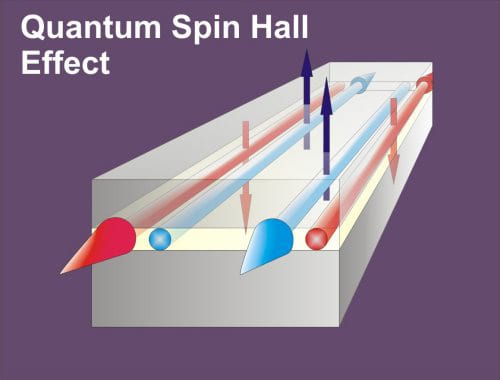
Five physicists who brought us the quantum spin-Hall effect and topological insulators have been awarded this year’s Europhysics Prize from the European Physical Society’s condensed-matter division. The winners are Shoucheng Zhang of Stanford University; Charles Kane and Eugene Mele of the University of Pennyslvania; and Hartmut Buhmann and Laurens Molenkamp of Würzburg University in Germany.
Since being confirmed experimentally in 2007, the two related phenomena have become major topics of research in solid-state physics with hundreds of papers on the arXiv preprint server covering the subjects. The quintet’s pioneering research could also allow physicists to catch the first glimpse of an elusive particle called the Majorana fermion and lead to noise-resistant quantum computers.
Topological framework
Zhang, Kane and Mele are honoured for their theoretical work on the quantum spin-Hall effect (QSHE), which occurs in certain very thin insulators. It involves spin-up electrons conducting along one edge of the insulator, with spin-down electrons conducting along the opposite edge. The trio’s efforts laid down a theoretical framework for topological insulators – materials that are insulators in the bulk but are good electrical conductors on the surface.
In 2005 Kane and Mele proposed a general theory that predicts which materials are 2D topological insulators. The pair identified graphene – sheets of carbon just one atom thick – as a candidate, although it has not been feasible to establish this experimentally. Working independently, however, Zhang predicted in 2006 that mercury telluride should be a 2D topological insulator. This prediction was confirmed experimentally in 2007 by Buhmann and Molenkamp, the other two winners of this year’s prize.
Joel Moore of the University of California, Berkeley said the award is a “fitting recognition of an exciting discovery that shows the constructive interaction between theoretical predictions and experimental work in condensed matter physics”.
Since extended to 3D
Such materials are called 2D topological insulators because the effect occurs in extremely thin materials where the electrons are confined to two dimensions and the effect is related to the shape (or topology) of the electron wave functions. In 2007 Kane and Mele – and independently Moore, Leon Balents and Rahul Roy – realized that topological insulators can also exist in thicker 3D materials. This was confirmed experimentally in 2008 by Zahid Hasan and colleagues at Princeton University.
Marcel Franz of the University of British Columbia told physicsworld.com that 3D topological insulators “constitute a truly new phase of quantum matter”. “We thought we understood all the aspects of the band theory in solids but these recent developments show that in fact we completely missed some topological aspects that proved to be of fundamental importance,” he added.
Particle and anti-particle
Physicists are particularly keen to see what happens at the interface between a topological insulator and a superconductor. Some physicists believe that such structures could harbour a new type of quasiparticle reminiscent of the “Majorana fermions”, which were predicted in 1937 by the Italian theorist Ettore Majorana but have yet to be seen.
Majorana fermions are electron-like particles that are their own anti-particles. They are neither fermions nor bosons, and instead obey non-Abelian statistics. The quantum states of such particles are expected to be highly resistant to perturbations by environmental noise, making them ideal candidates for quantum computers.


